曼昆《宏观经济学》第12章 - 副本
- 格式:pdf
- 大小:335.53 KB
- 文档页数:42


曼昆《宏观经济学》(第6、7版)第12章重访开放经济:蒙代尔-弗莱明模型与汇率制度课后习题详解跨考网独家整理最全经济学考研真题,经济学考研课后习题解析资料库,您可以在这里查阅历年经济学考研真题,经济学考研课后习题,经济学考研参考书等内容,更有跨考考研历年辅导的经济学学哥学姐的经济学考研经验,从前辈中获得的经验对初学者来说是宝贵的财富,这或许能帮你少走弯路,躲开一些陷阱。
以下内容为跨考网独家整理,如您还需更多考研资料,可选择经济学一对一在线咨询进行咨询。
一、概念题1.蒙代尔-弗莱明模型(Mundell-Fleming model)答:蒙代尔-弗莱明模型将封闭经济的宏观分析工具IS LM模型扩展到开放经济之中,对固定汇率制与浮动汇率制下财政政策和货币政策的作用机制、政策效力进行了分析研究,是从货币金融角度为主对开放经济进行宏观分析的基本分析框架。
在西方文献中,蒙代尔—弗莱明模型被称为开放经济下进行宏观分析的工作母机,对国际金融学的发展有很大影响。
蒙代尔-弗莱明模型的分析对象是一个小型开放经济国家。
分析的前提是:总供给曲线是水平的;即使在长期里,购买力平价也不存在,汇率完全依据国际收支状况进行调整;不存在汇率将发生变动的预期,投资者风险中立。
在以上前提下,蒙代尔-弗莱明模型得出的结论是:固定汇率制下财政政策相对有效,货币政策相对无效,但货币政策可以改变基础货币的构成;浮动汇率制下货币政策相对有效,财政政策相对无效,但财政政策可以改变总支出的构成。
2.浮动汇率(floating exchange rates)答:浮动汇率制是指现实汇率不受平价的限制,随外汇市场供求状况变动而波动的一种汇率制度,它是与固定汇率制相对而言的。
1973年2月,布雷顿森林体系崩溃后,西方各主要工业国先后都实现了浮动汇率制。
在浮动汇率制下,一国货币不再规定金平价,不再规定对外货币的中心汇率,不再规定现实汇率的波动幅度,货币当局也不再承担维持汇率波动界限的义务。
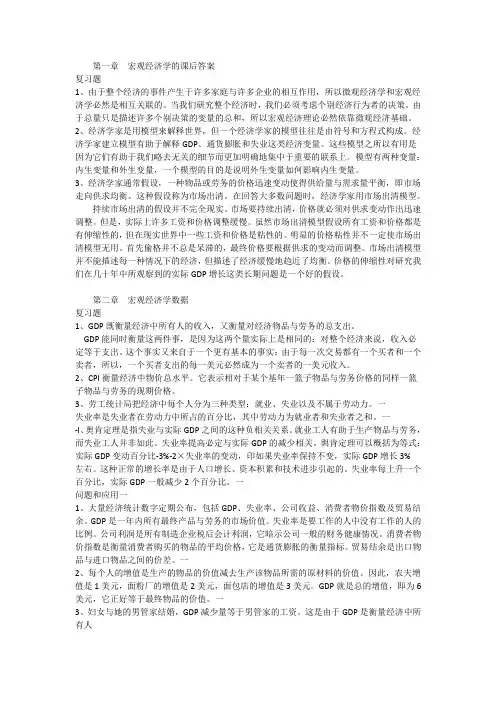
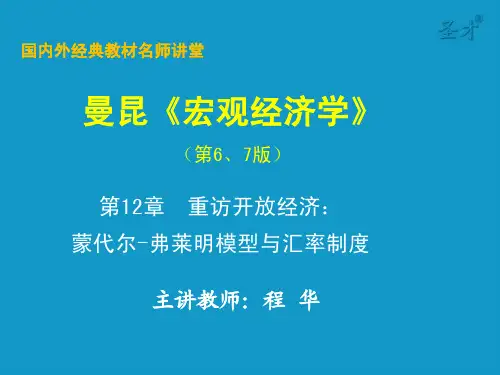
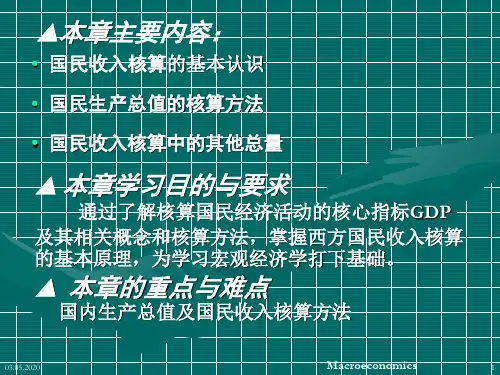
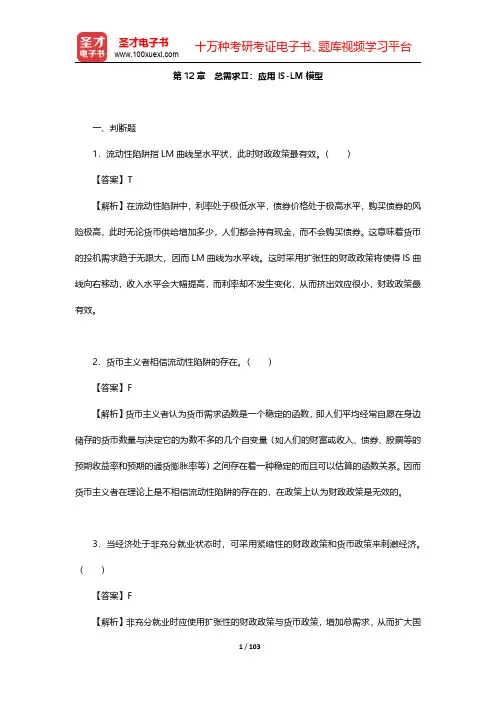

曼昆经济学原理英文版文案加习题答案12章WHAT’S NEW IN THE S EVENTH EDITION:All tables have been updated to the most recently available numbers. A new In the News box on “Tax Expenditures" has been added.LEARNING OBJECTIVES:By the end of this chapter, students should understand:➢how the U.S. government raises and spends money.➢the efficiency costs of taxes.➢alternative ways to judge the equity of a tax system.➢why studying tax incidence is crucial for evaluating tax equity.➢the trade-off between efficiency and equity in the design of a tax system.CONTEXT AND PURPOSE:Chapter 12 is the third chapter in a three-chapter sequence on the economics of the public sector. Chapter 10 addressed externalities. Chapter 11 addressed public goods and common resources. Chapter 12 addresses the tax system. Taxes are inevitable because when the government remedies an externality, provides a public good, or regulates the use of a common resource, it needs tax revenue to perform these functions.The purpose of Chapter 12 is to build on the lessons learned about taxes in previous chapters. We have seen that a tax reduces the quantity sold in a market, that the distribution of the burden of a tax depends on the relative elasticities of supply and demand, and that taxes cause deadweight losses. We expand the study of taxes in Chapter 12 by addressing how the U.S. government raises and spends money. The difficulty of making a tax system both efficient and equitable is then discussed.KEY POINTS:• The U.S. government raises revenue using various taxes. The most important taxes for thefederal government are individual income taxes and payroll taxes for social insurance. The most important taxes for state and local governments are sales taxes and property taxes.• The efficiency of a tax system refers to the costs it imposes on taxpayers. There are two costsof taxes beyond the transfer of resources from the taxpayer to the government. The first is the deadweight loss that arises as taxes alter incentives and distort the allocation of resources. The second is the administrative burden of complying with the tax laws.• The equity of a tax system concerns whether the tax burden is distributed fairly among thepopulation. According to the benefits principle, it is fair for people to pay taxes based on the benefits they receive from the government. According to the ability-to-pay principle, it is fair for people to pay taxes based on their capability to handle the financial burden. Whenevaluating the equity of a tax system, it is important to remember a lesson from the study of tax incidence: The distribution of tax burdens is not the same as the distribution of tax bills.• When considering changes in the tax laws, policymakers often face a trade-off betweenefficiency and equity. Much of the debate over tax policy arises because people give different weights to these two goals.CHAPTER OUTLINE:I. A Financial Overview of the U.S. GovernmentA. Figure 1 shows the level of government revenue in the United States, including federal, state, and local governments, as a percentage of total income for the U.S. economy.1. The role of government has grown substantially over the past century.2. The government’s revenue from taxation has grown at a faster rate than the economy’s levelof income.B. Table 1 compares the tax burden for several major countries, as measured by the government’stax revenue as a percentage of the nation’s total income.1. The United States has a low tax burden compared to most other advanced economies.2. Many European nations have much higher taxes, which finance a more generous social safetynet.C. The Federal Government1. Receiptsa. Table 2 reports the receipts of the federal government in 2011.b. Total receipts were $2,520 billion or $8,077 per person.c. The largest source of revenue is the individual income tax.d. A family’s income tax liability is how much it owes in taxes based on income. This tax isnot proportional to income. It is based on income minus deductions, and the tax rate rises as income rises. Table 3 presents federal tax rates for 2013.e. Other important revenue sources include payroll taxes (social insurance taxes), the corporate income tax, and excise taxes.2. Spendinga. Table 4 reports where the federal government spent its budget in 2011.b. Total spending was $3,757 billion or $12,042 per person.c. The largest category of expenditure is for income security, which includes Social Security, unemployment insurance payments, and welfare payments. The second largest expenseis health programs, including Medicare, Medicaid, and spending on medical research.d. The next largest category of spending is national defense.e. Another important category of expenditure is net interest on the federal debt.3. Definition of budget deficit: an excess of government spending over governmentreceipts.spending.D. Case Study: The Fiscal Challenge Ahead1. From 2009 to 2012, the U.S. federal government had budget deficits that exceeded $1 trillion every year, the largest budget shortfalls since World War II.2. Long-term projections of the government’s budget show that this is expected to rise dramatically in the decades ahead.a. The population ages 65 and older is growing; thus, Medicare and Social Security expenditures will rise as well.b. In addition, the costs of Medicare, Medicaid and government-subsidized health insurance are affected by the rising cost of medical care.E. State and Local Government1. Receiptsa. Table 5 reports the receipts from state and local governments for 2011.b. Total receipts were $2,064 billion or $6,615 per person.c. The two most important taxes for state and local governments are sales taxes andproperty taxes.d. State and local governments also levy individual and corporate income taxes.e. State governments also receive funding from the federal government.2. Spendinga. Table 6 shows how state and local governments spent their budgets in 2011.b. The largest category of spending was education, while the second largest category washealth programs.II. Taxes and EfficiencyA. Well-designed tax policies minimize the deadweight losses that occur when taxes distortincentives. They also minimize the administrative burdens that taxpayers face when complying with tax laws.B. Deadweight Losses1. Taxes lead to deadweight losses because they lower total surplus.2. Case Study: Should Income or Consumption Be Taxed?a. Because interest income is taxed, the current income tax laws discourage saving.b. If consumption (instead of income) is taxed, this disincentive disappears.c. European nations tend to rely more on consumption taxes than does the United States.C. Administrative Burden1. The current tax system is quite burdensome because of the large amount of paperworkrequired both when filling out tax forms and keeping records throughout the year.2. Many taxpayers spend resources hiring accountants and tax lawyers.a. People often need help filling out complex tax forms.b. Individuals may also want to learn how to arrange their affairs to reduce their tax burden.D. Marginal Tax Rates versus Average Tax Rates1. Definition of average tax rate: total taxes paid divided by total income.2. Definition of marginal tax rate: the amount that taxes increase from an additionaldollar of income.3. The average tax rate measures the sacrifice made by a taxpayer; the marginal tax ratemeasures how much the tax system distorts incentives.E. Lump-Sum Taxes1. Definition of lump-sum tax: a tax that is the same amount for every person.2. For this type of tax, the marginal tax rate is equal to zero.3. This is the most efficient type of tax because it does not distort incentives and thus has noeffect on total surplus. There is also little administrative burden with this type of tax.4. However, a lump-sum tax would take the same amount from the poor and the rich, whichmost people would view as unfair.III. Taxes and EquityA. The Benefits Principle1. Definition of benefits principle: the idea that people should pay taxes based on thebenefits they receive from government services.2. This principle tries to make public goods similar to private goods.3. An example of this would be the tax on gasoline, especially if revenues from the tax are used to build or maintain roads.B. The Ability-to-Pay Principle1. Definition of ability-to-pay principle: the idea that taxes should be levied on aperson according to how well that person can shoulder the burden.2. Definition of vertical equity: the idea that taxpayers with a greater ability to paytaxes should pay larger amounts.a. Three tax systems: proportional, regressive, and progressive.b. Definition of proportional tax: a tax for which high-income and low-incometaxpayers pay the same fraction of income.c. Definition of regressive tax: a tax for which high-income taxpayers pay a smaller fraction of their income than do low-income taxpayers.d. Definition of progressive tax: a tax for which high-income taxpayers pay a larger fraction of their income than do low-income taxpayers.e. Case Study: How the Tax Burden Is Distributed – Table 8 shows that the tax burden in this country is highly progressive. In addition, studies have shown that, if transferpayments are also taken into account, the degree of progressivity is substantial.3. Definition of horizontal equity: the idea that taxpayers with similar abilities to pay taxes should pay the same amount.C. Tax Incidence and Tax Equity1. The burden of a tax is not always borne by who pays the tax bill.2. Example: tax on fur coats. This will ultimately affect those who sell and produce the fur coats because the quantity of fur coats demanded will fall due to the increase in price.3. Case Study: Who Pays the Corporate Income Tax?a. The corporate income tax is popular among voters because a corporation is nonhumanand faceless.b. However, the burden of the corporate tax falls on stockholders, customers, and workers.c. An increase in corporate taxes means an increase in the cost of producing the product.Firms will cut back production (which lowers supply and raises the price to the consumer) and possibly lay off workers (which causes unemployment, lower wages, or both).D. In the News: Tax Expenditures1. Eliminating tax expenditures, special tax cuts for things like mortgage interest and charitablegiving, could result in lower taxes and fiscal sustainability.2. This article from The New York Times discussing the benefits of eliminating tax expendituresand the politics associated with such a proposal.IV. Conclusion: The Trade-off between Equity and EfficiencySOLUTIONS TO TEXT PROBLEMS:Quick Quizzes1. The two most important sources of tax revenue for the federal government are individualincome taxes and payroll taxes (social insurance taxes). The two most important sources oftax revenue for state and local governments are sales taxes and property taxes.2. The efficiency of a tax system depends on the costs of collecting a given amount of taxrevenue. One tax system is more efficient than another if the same amount of tax revenuecan be raised at a lower cost.A tax system can be inefficient because of the deadweight losses that result when taxesdistort the decisions that people make and because of the administrative burdens thattaxpayers bear as they comply with tax laws. An efficient tax system has low deadweightlosses and small administrative burdens.3. The benefits principle is the idea that people should pay taxes based on the benefits theyreceive from government services. It tries to make public goods similar to private goods bymaking those who benefit more from the public good pay more for it. The ability-to-payprinciple is the idea that taxes should be levied on a person according to how well thatperson can shoulder the burden. It tries to equalize the sacrifice each person makes towardpaying taxes.Vertical equity is the idea that taxpayers with greater ability to pay should pay largeramounts. Horizontal equity is the idea that taxpayers with similar abilities to pay should paythe same amount.Studying tax incidence is important for determining the equity of a tax system becauseunderstanding how equitable the tax system is requires understanding the indirect effects oftaxes. In many cases, the burden of the tax is borne by individuals other than those whoactually pay the tax.Questions for Review1. Over the past century, the government’s tax revenue has grown more rapidly than the rest ofthe economy. The ratio of government revenue to GDP has increased over time.2. Corporate profits are taxed first when the corporate income tax is taken out of acorporation's income. When the profits are used to pay dividends to the corporation'sshareholders, they are taxed again through individual income tax.3. The burden of a tax to taxpayers is greater than the revenue received by the governmentbecause: (1) taxes impose deadweight losses by reducing the quantity of goods producedand purchased to below their efficient level; and (2) taxes entail a costly administrativeburden on taxpayers.4. Some economists advocate taxing consumption rather than income because taxing incomediscourages saving. A consumption tax would not distort individuals’ saving decisions.5. The marginal tax rate on a lump-sum tax is zero. This type of tax has no deadweight loss,because it does not distort incentives.6. Wealthy taxpayers should pay more taxes than poor taxpayers should because: (1) theybenefit more from public services; and (2) they have a greater ability to pay.7. Horizontal equity refers to the idea that families in the same economic situation should betaxed equally. The concept of horizontal equity is hard to apply because families differ inmany ways, so it is not obvious how to tax them equitably. For example, two families withthe same income may have different numbers of children and different levels of medicalexpenses.Quick Check Multiple Choice1. b2. c3. a4. a5. d6. cProblems and Applications1. The federal government had a budget deficit in 2013. Policymakers expect budget deficitsover the next decade.2. a. The increase in revenue of the total government is attributable more to increases in stateand local government revenue than to federal government revenue. In 1964, state andlocal government revenue was 37% of total government revenue; by 2012, it had risento more than 48%.b. Personal income taxes accounted for more of the total revenue of federal and state andlocal governments in 2012 than in 1964; social insurance taxes accounted for asubstantially greater proportion in 2012 than in 1964; and corporate taxes accounted fora lower proportion in 2012 than in 1964.c. Transfer payments now account for a much greater proportion of the total expendituresof federal and state and local governments, while purchases account for a much smallerproportion. Expenditures on interest and subsidies are consistent.3. a. If the number of retirees is rising and total expenditures are frozen, then benefits perretiree will decline over time. Because the number of workers is rising, albeit slowly, taxpayments per worker would decline slowly over time.b. If benefits per retiree were frozen, total expenditures would rise quickly, along with thenumber of retirees. To pay for the increased expenditures, tax payments per workerwould rise, because the number of workers isn't growing as rapidly as the number ofretirees.c. If tax payments per worker were frozen, total expenditures would rise slowly, at thesame rate as the growth rate of the number of workers. Because the number of retireesis rising more rapidly, benefits per retiree would decline over time.d. The answers to parts (a), (b), and (c) suggest there is no easy solution. Either workerswill pay more per person or retirees will get fewer benefits per person. Policymakers mayeventually be forced to compromise, both reducing benefits per retiree and increasingtax payments per worker.4. If you earn $20,000 a year, then you pay federal income taxes in two parts: 10% on the first$8,925 of income and 15% on the amount above $8,925. Thus, your federal income taxesare ($8,925 ⨯ 0.10) + ($11,075 ⨯ 0.15) = $892.50 + $1661.25 = $2,553.75. You also pay $20,000 ⨯ 0.153 = $3,060 in federal payroll taxes and $20,000 ⨯ 0.04 = $800 in stateincome taxes, for a total tax bill of $6,413.75. Your average tax rate is $6,441.25/$20,000 =0.321 = 32.1%. Your marginal tax rate is 0.15 + 0.153 + 0.04 = 0.343 = 34.3%.If you earn $40,000 a year, then you pay federal income taxes in three parts: 10% on the first $8,925 of income, 15% for additional income up to $36,425, and 25% for the remaining $3,5750 of income. Thus, your federal income taxes are ($8,925 ⨯ 0.10) + ($27,500 ⨯ 0.15) + ($3,575 ⨯ 0.25) = $892.50 + $4,125 + $893.75 = $5911.25. You also pay $40,000 ⨯0.153 = $6,120 in federal payroll taxes, and $40,000 ⨯ 0.04 = $1,600 in state income taxes.Your total tax bill is $13,631.25. Your average tax rate is $13,631.25/$40,000 = 0.341 =34.1%. Your marginal tax rate is 0.25 + 0.153 + 0.04 = 0.443 = 44.3%.5. Excluding food and clothing from the sales tax is justified on equity grounds because poorpeople spend a greater proportion of their income on those items. By exempting them from taxation, the system makes the rich bear a greater burden of taxation than the poor. From the point of view of efficiency, however, excluding food and clothing from the sales tax is inefficient, because the incentives to purchase food and clothing rather than other items are likely affected by this tax exemption. This leads to an inefficient allocation of resources. In addition, because the demand for food and clothing is likely to be relatively inelastic, thedeadweight loss from a tax on these goods would be relatively small (when compared with a tax on a good whose demand is relatively elastic).6. a. An individual must pay taxes on the asset only when he or she sells it. Thus, this tax lawaffects the individual’s decision of whether to keep or sell the asset. Tax revenues onaccrued capital gains are only received by the government when an individual actuallysells the asset. Lowering the tax rate on capital gains may induce individuals to sellassets that they have been holding to avoid paying the taxes on the accrued capital gains.b. Because capital gains are not realized and thus taxed until the investment is sold,investors can avoid the tax by not selling the investment. When capital gains taxes arelowered, even temporarily, the investor has an incentive to sell the investment while thetax is lower. Thus, sales to realize capital gains will increase at the lower rate and so willtax revenue on the increased volume of transactions.c It is inefficient to tax only realized capital gains because it distorts the incentives anindividual faces with regard to keeping or selling a particular asset. However, it may bedifficult to estimate the rise in the value of an asset prior to its sale.7. If the state raises its sales tax from 5% to 6%, it is not plausible that sales tax revenue willincrease 20%. The increase in the tax rate is 20%, so the only way tax revenue couldincrease 20% would be if total spending didn't fall in response to the tax increase, which is unlikely. Instead, the higher tax would raise the price of goods, so people would spend less.Thus, tax revenue might go up, because the tax rate is higher, but by less than 20%. There is a possibility that tax revenues will fall.8. The effect of the Tax Reform Act of 1986 on interest payments was to reduce consumer debtand increase home equity debt. People started financing general expenditures through home equity loans and paid down their mortgages less quickly.9. a. The fact that visitors to many national parks pay an entrance fee is an example of thebenefits principle, because people are paying for the benefits they receive.b. The fact that local property taxes support elementary and secondary schools is anexample of the ability-to-pay principle, because if you own more expensive property, you must pay more tax.c. The setup of airport trust funds is an example of the benefits principle, because use ofthe airport generates tax revenue that pays for upkeep of the airport.。
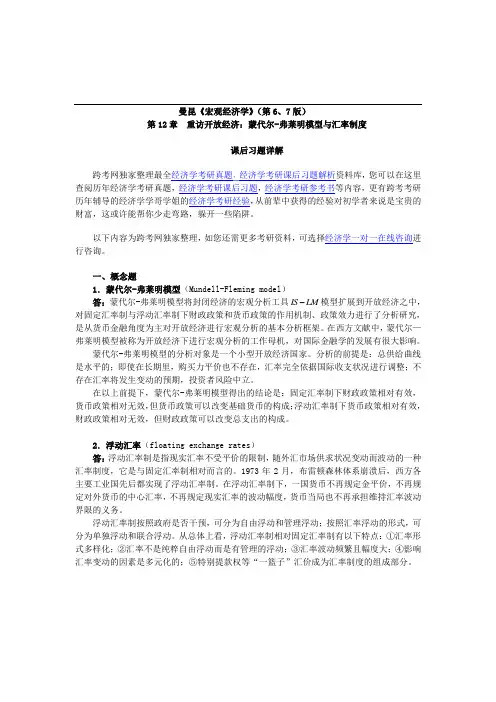
曼昆《宏观经济学》(第6、7版)第12章重访开放经济:蒙代尔-弗莱明模型与汇率制度课后习题详解跨考网独家整理最全经济学考研真题,经济学考研课后习题解析资料库,您可以在这里查阅历年经济学考研真题,经济学考研课后习题,经济学考研参考书等内容,更有跨考考研历年辅导的经济学学哥学姐的经济学考研经验,从前辈中获得的经验对初学者来说是宝贵的财富,这或许能帮你少走弯路,躲开一些陷阱。
以下内容为跨考网独家整理,如您还需更多考研资料,可选择经济学一对一在线咨询进行咨询。
一、概念题1.蒙代尔-弗莱明模型(Mundell-Fleming model)答:蒙代尔-弗莱明模型将封闭经济的宏观分析工具IS LM模型扩展到开放经济之中,对固定汇率制与浮动汇率制下财政政策和货币政策的作用机制、政策效力进行了分析研究,是从货币金融角度为主对开放经济进行宏观分析的基本分析框架。
在西方文献中,蒙代尔—弗莱明模型被称为开放经济下进行宏观分析的工作母机,对国际金融学的发展有很大影响。
蒙代尔-弗莱明模型的分析对象是一个小型开放经济国家。
分析的前提是:总供给曲线是水平的;即使在长期里,购买力平价也不存在,汇率完全依据国际收支状况进行调整;不存在汇率将发生变动的预期,投资者风险中立。
在以上前提下,蒙代尔-弗莱明模型得出的结论是:固定汇率制下财政政策相对有效,货币政策相对无效,但货币政策可以改变基础货币的构成;浮动汇率制下货币政策相对有效,财政政策相对无效,但财政政策可以改变总支出的构成。
2.浮动汇率(floating exchange rates)答:浮动汇率制是指现实汇率不受平价的限制,随外汇市场供求状况变动而波动的一种汇率制度,它是与固定汇率制相对而言的。
1973年2月,布雷顿森林体系崩溃后,西方各主要工业国先后都实现了浮动汇率制。
在浮动汇率制下,一国货币不再规定金平价,不再规定对外货币的中心汇率,不再规定现实汇率的波动幅度,货币当局也不再承担维持汇率波动界限的义务。
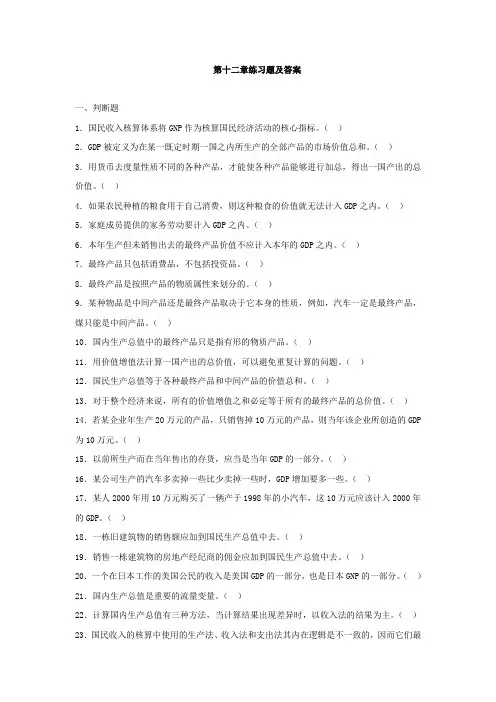
第十二章练习题及答案一、判断题1.国民收入核算体系将GNP作为核算国民经济活动的核心指标。
()2.GDP被定义为在某一既定时期一国之内所生产的全部产品的市场价值总和。
()3.用货币去度量性质不同的各种产品,才能使各种产品能够进行加总,得出一国产出的总价值。
()4.如果农民种植的粮食用于自己消费,则这种粮食的价值就无法计入GDP之内。
()5.家庭成员提供的家务劳动要计入GDP之内。
()6.本年生产但未销售出去的最终产品价值不应计入本年的GDP之内。
()7.最终产品只包括消费品,不包括投资品。
()8.最终产品是按照产品的物质属性来划分的。
()9.某种物品是中间产品还是最终产品取决于它本身的性质,例如,汽车一定是最终产品,煤只能是中间产品。
()10.国内生产总值中的最终产品只是指有形的物质产品。
()11.用价值增值法计算一国产出的总价值,可以避免重复计算的问题。
()12.国民生产总值等于各种最终产品和中间产品的价值总和。
()13.对于整个经济来说,所有的价值增值之和必定等于所有的最终产品的总价值。
()14.若某企业年生产20万元的产品,只销售掉10万元的产品,则当年该企业所创造的GDP 为10万元。
()15.以前所生产而在当年售出的存货,应当是当年GDP的一部分。
()16.某公司生产的汽车多卖掉一些比少卖掉一些时,GDP增加要多一些。
()17.某人2000年用10万元购买了一辆产于1998年的小汽车,这10万元应该计入2000年的GDP。
()18.一栋旧建筑物的销售额应加到国民生产总值中去。
()19.销售一栋建筑物的房地产经纪商的佣金应加到国民生产总值中去。
()20.一个在日本工作的美国公民的收入是美国GDP的一部分,也是日本GNP的一部分。
()21.国内生产总值是重要的流量变量。
()22.计算国内生产总值有三种方法,当计算结果出现差异时,以收入法的结果为主。
()23.国民收入的核算中使用的生产法、收入法和支出法其内在逻辑是不一致的,因而它们最后所计算出来的国民生产总值数量也可能是不一致的。
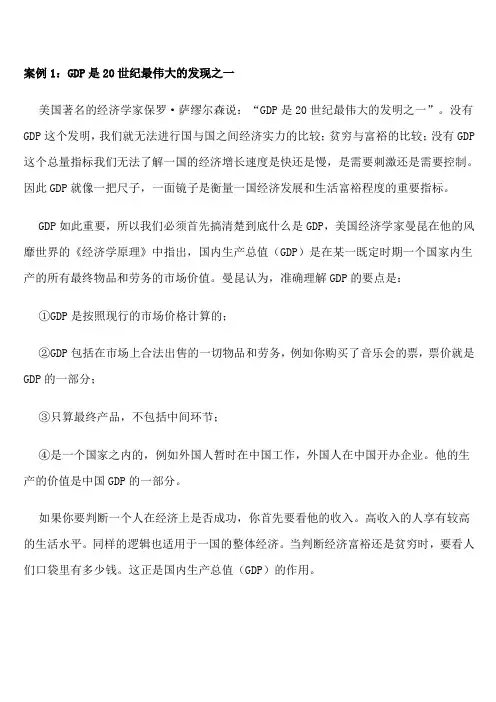
案例1:GDP是20世纪最伟大的发现之一美国著名的经济学家保罗·萨缪尔森说:“GDP是20世纪最伟大的发明之一”。
没有GDP这个发明,我们就无法进行国与国之间经济实力的比较;贫穷与富裕的比较;没有GDP 这个总量指标我们无法了解一国的经济增长速度是快还是慢,是需要刺激还是需要控制。
因此GDP就像一把尺子,一面镜子是衡量一国经济发展和生活富裕程度的重要指标。
GDP如此重要,所以我们必须首先搞清楚到底什么是GDP,美国经济学家曼昆在他的风靡世界的《经济学原理》中指出,国内生产总值(GDP)是在某一既定时期一个国家内生产的所有最终物品和劳务的市场价值。
曼昆认为,准确理解GDP的要点是:①GDP是按照现行的市场价格计算的;②GDP包括在市场上合法出售的一切物品和劳务,例如你购买了音乐会的票,票价就是GDP的一部分;③只算最终产品,不包括中间环节;④是一个国家之内的,例如外国人暂时在中国工作,外国人在中国开办企业。
他的生产的价值是中国GDP的一部分。
如果你要判断一个人在经济上是否成功,你首先要看他的收入。
高收入的人享有较高的生活水平。
同样的逻辑也适用于一国的整体经济。
当判断经济富裕还是贫穷时,要看人们口袋里有多少钱。
这正是国内生产总值(GDP)的作用。
GDP同时衡量两件事:经济中所有人的总收入和用于经济中物品与劳务产量的总支出。
GDP既衡量总收入又衡量总支出的秘诀在于这两件事实际上是相同的。
对于一个整体经济而言,收入必定等于支出。
这是为什么呢?一个经济的收入和支出相同的原因就是一次交易都有两方:买者和卖者。
如你雇一个小时工为你做卫生,每小时10元,在这种情况下小时工是劳务的卖者,而你是劳务的买者。
小时工赚了10元,而你支出了10元。
因此这种交易对经济的收入和支出做出了相同的贡献。
无论是用总收入来衡量还是用总支出来衡量,GDP都增加了10元。
由此可见,在经济中,每生产一元钱,就会产生一元钱的收入。
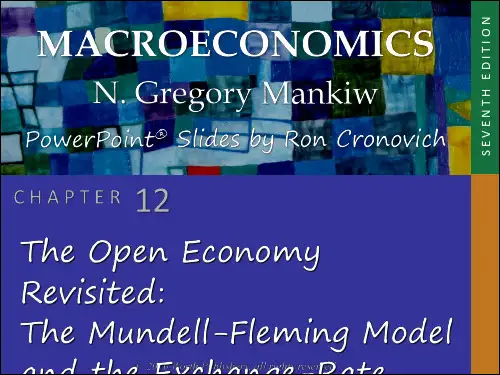
曼昆《宏观经济学》(第6、7版)第12章重访开放经济:蒙代尔-弗莱明模型与汇率制度课后习题详解跨考网独家整理最全经济学考研真题,经济学考研课后习题解析资料库,您可以在这里查阅历年经济学考研真题,经济学考研课后习题,经济学考研参考书等内容,更有跨考考研历年辅导的经济学学哥学姐的经济学考研经验,从前辈中获得的经验对初学者来说是宝贵的财富,这或许能帮你少走弯路,躲开一些陷阱。
以下内容为跨考网独家整理,如您还需更多考研资料,可选择经济学一对一在线咨询进行咨询。
一、概念题1.蒙代尔-弗莱明模型(Mundell-Fleming model)答:蒙代尔-弗莱明模型将封闭经济的宏观分析工具IS LM模型扩展到开放经济之中,对固定汇率制与浮动汇率制下财政政策和货币政策的作用机制、政策效力进行了分析研究,是从货币金融角度为主对开放经济进行宏观分析的基本分析框架。
在西方文献中,蒙代尔—弗莱明模型被称为开放经济下进行宏观分析的工作母机,对国际金融学的发展有很大影响。
蒙代尔-弗莱明模型的分析对象是一个小型开放经济国家。
分析的前提是:总供给曲线是水平的;即使在长期里,购买力平价也不存在,汇率完全依据国际收支状况进行调整;不存在汇率将发生变动的预期,投资者风险中立。
在以上前提下,蒙代尔-弗莱明模型得出的结论是:固定汇率制下财政政策相对有效,货币政策相对无效,但货币政策可以改变基础货币的构成;浮动汇率制下货币政策相对有效,财政政策相对无效,但财政政策可以改变总支出的构成。
2.浮动汇率(floating exchange rates)答:浮动汇率制是指现实汇率不受平价的限制,随外汇市场供求状况变动而波动的一种汇率制度,它是与固定汇率制相对而言的。
1973年2月,布雷顿森林体系崩溃后,西方各主要工业国先后都实现了浮动汇率制。
在浮动汇率制下,一国货币不再规定金平价,不再规定对外货币的中心汇率,不再规定现实汇率的波动幅度,货币当局也不再承担维持汇率波动界限的义务。